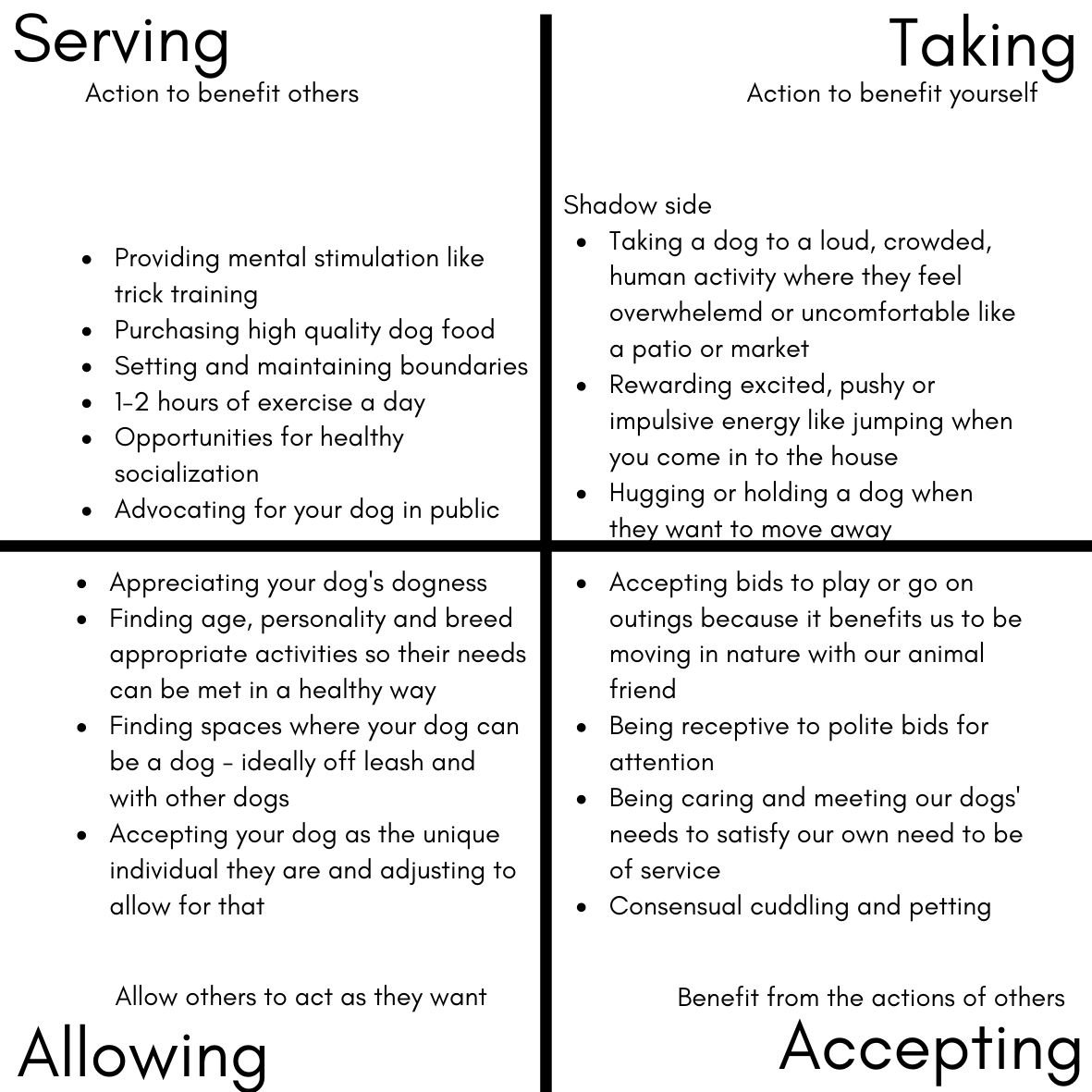What I’m passionate about teaching people, the work I feel I have to do in the world to advocate for dogs, what I know to be true is that dogs are a different species and so many of the behaviors we struggle with are rooted in how we see them and how that leads us to treat them in a way that is not appropriate for who they are as animals or helpful for our greater goals with them.
We love giving to our dogs. We take pride in it. They are the screen savers on our phones, we wear shirts that say ‘pet parent,’ we base our identity off bring a dog owner because it’s such a big and important part of our lives. We love giving to our dogs, but sometimes we don’t always know what they need, what they want, or how to balance that with what we feel best when giving.
The Wheel of Consent
I love this concept and I think it is a great way of better understanding our interactions with our dogs as well as with people. Betty Martin came up with a four quadrant diagram to help us conceptualize a system of giving and receiving. We can give in a way that is generous or selfish and we can receive in a way that is fulfilling to us or doing a service for the giver.
Let’s say you are in a bad mood and I ask you simply “do you want to go for a walk?” I know that you usually enjoy walking and, while it isn’t exactly what I’d like to do in that moment, I think it would make you feel better so I suggest it. You have had a long day and are feeling tired, but you care about me and since I seem to want to go walk and desire your company, you agree. Then we have two people on a walk, neither of whom really want to be here! Betty’s chart helps give the clarity of intention and language to where I can say “would it make you feel better if I joined you for a walk?” to which you could say that you appreciated the offer and may take me up on it another time, but feel like resting.
The Wheel of Consent ties in to our dogs to help us get clear on what a dog needs or enjoys
Serving - where you take an action to benefit the other
Taking - where you want something that will benefit you
Allowing - where you let another act the way they want
Accepting - where you benefit from the actions of the other
Serving and allowing are giving in nature while taking and accepting are receiving.
Let’s talk about dogs:
Serving - giving your dog one to two hours of exercise a day
Yes! Any dog, any age. You may have to build up to it, but every dog would benefit from an hour outside the house engaged in an activity. Maybe it’s broken up into 20 minute chunks, but to me this is the minimum daily investment any good dog owner needs to make. If you are out with your dog less than a minimum of one hour every day, meet this daily quota for one month straight and your behavior problem may radically change.
Taking - rewarding your dog when they excitedly greet you at the door, hugging or holding your dog when they strain to get away, taking your dog to a patio to sit next to you in a loud, crowded, public space where they aren’t free to move or interact naturally (especially when you haven’t exercised them to the point of exhaustion that day)
These are actions we take with our dogs that benefit us, but really aren’t what our dog wants or needs. It feels good to have someone in our lives excitedly bound up to us when we get home, but by returning that excited energy, petting them, cooing to them, or pretty much doing anything but ignoring or correcting them, we are amplifying their anxiety at being left alone, rewarding an excited state (and what we reward we get more of!), teaching them bad manners for greetings that could scare or upset company and set a bad habit of generally greeting excitedly that will have a massive negative impact on their interactions with other dogs. We don’t realize the harm we can do by allowing ourselves this indulgence. After all, being excitedly greeted by our dog when we come in was one of the main perks of dog ownership our culture marketed to us. It’s part of why we got them, now the mean trainer lady is telling you that it isn’t good for the dog, your relationship with them, or their relationship with other animals and people. Sorry, everyone. Trust me, if I had better news I’d be sharing it.
Allowing - Teaching your dog to be safe off leash so they can interact with dogs, smell, move, run and explore naturally
We need to let dogs be dogs! Training seems to limit dogs being dogs in the stereotypical way we think of dogs. I find training doesn’t limit a dog’s life, it allows for it. I make sure my dog and I have a relationship where they listen to me unconditionally so I can keep them safe. I teach them to not let me get out of their sight so they don’t get lost. I teach them to come when called so they can keep enjoying the privilege of being free. I teach them to calmly greet other dogs so when I’m not holding the leash they don’t make dangerous choices. Yes, I’m limiting some of their natural behaviors, but these are the dark sides of their personality coin - the rude, pushy, impulsive, behaviors that could get them lost, in a fight, hit by a car, or even ordered to be euthanized. By saying no to certain behaviors, I’m giving a big green light to something my dog will value above all else, the ability to move freely through the hiking trails and parks off leash.
Accepting - Accepting their polite bids for attention and giving them scratches, pets, playing calm tug, and enjoying sweet kisses
Accepting is where we benefit from the actions of others that they also enjoy. Most of the time we think of the list above, enjoying our dogs’ affectionate expressions so we can engage in what we as humans know to be loving interactions. For me, what dogs allow us to do is something that we need and want even more than getting love - the opportunity to be of service. We want someone to give to, to consider, even to sacrifice for.
After years of working with dogs, my list looks a little different.
The way I serve a dog and the gift I accept from them is a higher calling for me to center within myself and BE who they need me to be so they can feel safe in the world. For their sake I am calm, confident, aware of the environment, deliberate about how we move through the world, mindful of their energy, where their attention is and if they are being impulsive and pushy or tuned in and respectful.
Yes, I miss out on some of the fun other dog owners have. I know better than to think a dog running wild or playing rough is having fun because I know that energy is one that is more likely to cause an accident or dog fight. I don’t let them run up to me, lean on me, push into my space or flip my hand for more pets because I know that it’s rude and will affect how they see me and how well they listen to me. I know that a dog dragging to a smell is learning to pull, be pushy and getting into an instinctive mindset that will lead to them getting in trouble either within a few minutes or at another time.
While being a dog trainer and knowing what I know has meant giving up on a lot of things that our culture sees as the fun of dogs, I also get to enjoy things many owners never get to experience. I can be tuned in to dogs in a way that feels like having ESP. I can teach any dog to walk nicely on the leash and dogs who don’t pull get walked more. I help dogs learn to be safe off leash and after a lot of time saying ‘no’ to the things that aren’t allowed off leash, they get a life of ‘yes’ enjoying the trails.

